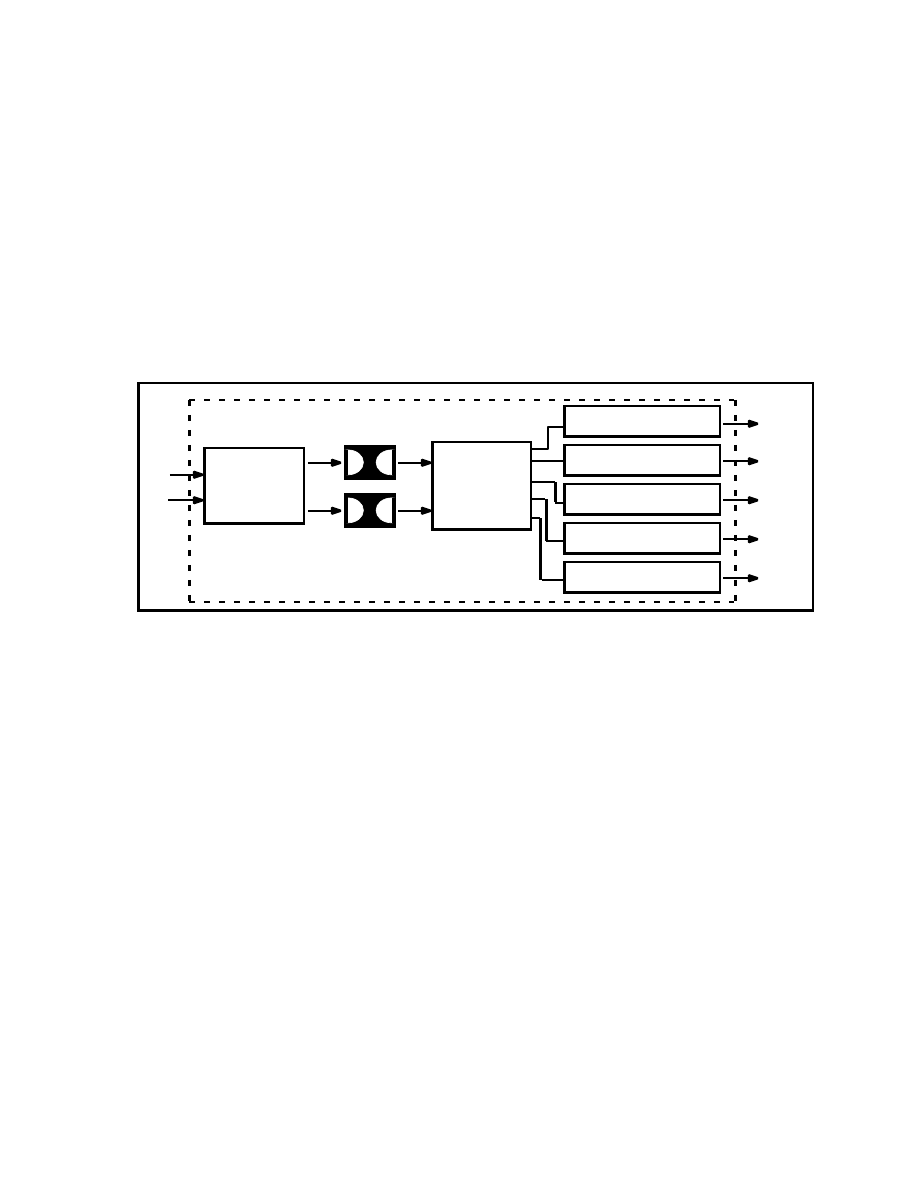ВУЗ: Казахская Национальная Академия Искусств им. Т. Жургенова
Категория: Учебное пособие
Дисциплина: Не указана
Добавлен: 03.02.2019
Просмотров: 12337
Скачиваний: 6

D
DLS-2: Downloadable Sounds Level 2. An improvement over DLS which moves closer to
enabling multitrack audio and MIDI programs to be used by audio and MIDI hardware and
software interchangeably. This is accomplished by transferring entire multisampled instru-
ments, along with the MIDI data, to the end-user’s platform, resulting in playback as the
author intended. In addition to the specification of DLS-1, DLS-2 specifies: resonant filter
control, adds delay and hold to envelope segments, effects routing for chorus and reverb, no
limit to the number of regions in any soundbank, each reason can have independent enve-
lope and filter data, and is extensible to include other forms of synthesis. Ratified by the
MMA in early 1999. See also MPEG-4.
DLT: Digital Linear Tape. A tape-based computer backup format developed by Quantum
Laboratories.
DMA: Direct Memory Access. A digital logic design which allows peripheral devices to
communicate directly with the system memory, rather than requiring the central processor
to stop whatever processing it was doing to control communications between an attached
device (usually having some kind of I/O function) and the computer memory.
DME: Dialog, Music, and Effects. The three basic stems of film soundtracks, originally
meant to denote the 35mm 3-track master mix of academy mono films
.
DN: See dialog normalization.
Dolby Digital™: The 5.1–channel digital format created by Dolby Laboratories, first used in
1992 for “Batman Returns.” In current usage, the term applies to both the Dolby 35mm
theatrical format, which contains the data printed optically between the sprocket holes, and
for video formats, such as DVD, laserdisc, and DTV. AC-3, as Dolby Digital was first called,
used RF modulation of the digital signal onto one of the analog tracks, making it possible to
fit an entire movie, along with the already existing digital tracks, onto a conventional laser-
disc; a demodulator was needed to recover the audio back into a digital bitstream.
The Dolby Digital format is a surround-sound, split-band, perceptual coding scheme. AC-3 was
designed as a 5.1 multichannel format, using approximately 13:1 lossy compression, and is
specified as the matrixing format for DVD and DTV. Also used in HDTV broadcasts, SR-D,
and DSD cinema productions. Versatile, in that parameters such as bit-rate and number of
channels can be tailored to particular applications, unique in that the data bits are distrib-
uted dynamically among the filter bands as needed by the particular frequency spectrum or
dynamic nature of the program. Data rates vary from 32kbps for a single mono channel to
as high as 640 kbps for 5.1 format. The data rate is 320kbps for film, 384kbps for laserdisc,
and 384kbps or 448kbps for DVD, although the maximum throughput for the specification is
640kbps. Dolby’s current decoder can accept incoming data at 32kHz, 44.1kHz, or 48kHz
sample rates, with bit depths of 16, 18, or 20 bits. The commercial competitor to the Dolby
Digital format is DTS. See metadata, audio coding mode.
Dolby Fax: See ISDN.

D
Dolby Motion Picture 4:2:4: A matrixed surround-sound system which combines multichan-
nel LCRS audio in such a way that the encoded signal forms a stereo-compatible, two-
channel format for recording and broadcasting. Originally developed in 1977 for “Star
Wars,” and now in wide use. As with any matrix system, it is impossible to completely re-
cover the original multichannel signals with perfect isolation. The decoder disguises this
problem through a steering process which emphasizes the signal emanating from its appro-
priate loudspeaker by canceling out a portion of the crosstalk in adjacent channels. See also
free encoding, Pro Logic.
Dolby noise: The Dolby-SR analog allows the comparison of the recorded Dolby noise on a
tape to that generated by the decoder, with four continuous seconds of noise to identify the
generator, and two 2-second sections of noise indicating that the monitoring is off-tape. This
allows for confirmation of correct EQ settings as well as playback verification. The
broadband reference signal used to correctly calibrate the different Dolby codecs is called
Dolby noise. See Dolby tone.
Dolby noise reduction: A type of two-ended, dynamic noise reduction for magnetic tape re-
cording and playback. The essential difference between a compander and the Dolby system is
that the Dolby system is frequency-dependent. The compander was developed to reduce
distortion. Dolby applies companding to frequency variations in addition to signal ampli-
tude variations, adjusting gain as frequency changes. The Dolby-A and Dolby-SR systems
are used for professional recording in studios. Consumer tape decks use either a Dolby-B or
Dolby-C system. Dolby-B operates only at high frequencies and reduces tape hiss by about
10dB. Dolby-C works over a slightly wider frequency range, providing a noise reduction of
up to 20dB. All of the Dolby systems operate on quiet passages, below levels of about -
10VU. Very strong signals, such as over 60dB or at frequencies below 500Hz are not affected
by the Dolby system because these signals are not degraded by tape noise. When the re-
corded signal is played back, the Dolby circuit reduces the accentuated high-frequency sig-
nals so that the frequency response of the record/playback system is flat, hence reducing also
the high-frequency tape hiss, improving the S/N ratio of the taped music. See asperity, Bark-
hausen effect, compander, dbx, spectral recording.
Dolby ProLogic™: A four-channel perceptual coding scheme developed by Dolby Labs
where an LCRS audio signal is converted into two channels of analog audio, then recovered
to yield discrete left, center, right, and mono surround channels. This is a hardware version
of their surround decoder originally developed for the Dolby Motion Picture 4:2:4 matrix sur-
round-sound system, developed for the Star Wars picture in 1977. If a subwoofer is used, it is
generally fed by lowpass-filtering a mix of the three front channels at the receiver.
Dolby SR™: Dolby-SR is a complex type of two-ended, dynamic split-band, noise reduction
compander system that outperforms Dolby-A, -B, or -C systems and also results in reduced
distortion in most cases. This was developed as an upgrade to the professional Dolby-A,
featuring an improvement in tracking accuracy and sliding bands, and closest to C-type
noise reduction. S-Type noise reduction is the consumer analog. See SR.D.
Dolby SR.D™: A system developed by the Dolby company for placing a digital audio
soundtrack onto 35mm film, first used in 1992. The soundtrack includes a Dolby Digital mix,
as well as an SR analog stereo optical track. The data are compressed and printed onto the
film between the sprocket holes. See surround-sound, perceptual coding, Dolby surround-sound,
spectral recording.

D
Dolby Stereo™: The original Dolby Surround system which used four audio channels car-
ried on a stereo optical track on 35mm film, using Dolby perceptual encoding. On 70mm film,
six audio channels are recorded on discrete magnetic tracks laid onto the film. In the
broadest and most common usage, the trademark that appears on movie prints,
advertisements, and posters which means that a given film has been released in prints that
employ Dolby A-Type noise reduction encoding. Beginning in 1987, Dolby-SR has been
available on 35mm stereo optical prints. Dolby Stereo on 70mm usually means four discrete
primary channels (LCRS) with the left-center and right-center tracks dedicated to low-
frequency information (below 250 Hz). The four tracks are normally use A-Type encoding,
although selected 70mm films, since 1987, have utilized Dolby-SR encoding. See film sound-
track.
2:4
Decoder
Dolby-A NR
or Dolby-SR
Dolby Stereo
Optical
Preamp
L
R
3rd-Octave EQ
Parametric EQ
3rd-Octave EQ
3rd-Octave EQ
Bass Extension
L
R
C
Sub
Surr
Dolby Surround™: The Dolby Laboratories trademark used for surround-encoded material
on non-film media, such as videocassettes, videodiscs, and television broadcasts, as well as
for home surround decoding devices that do not have matrixed center-speaker output. See
AC-3, Dolby Stereo, ProLogic, Dolby Motion Picture 4:2:4, SR.D, matrixing, surround-sound.
Dolby Surround EX™: The digital release format developed by Dolby Laboratories and
THX for use in “Star Wars: Episode One--The Phantom Menace.” Three surround tracks are
derived by matrix-encoding them in the two previously existing surround tracks. This
should not be referred to as a 6.1-channel format because the additional surround channel is
not a discrete channel.
Dolby tone: A reference tone, usually recorded at the head of a Dolby-A recorded tape, by
which the threshold levels of the Dolby noise reduction system are adjusted for proper en-
coding and decoding of the companded signal.
domain: In magnetic recording tape, the smallest ferric oxide particle that can be considered as
a separate magnet. Defined as
10
18
molecules of ferric oxide, or, less than one billionth of a
gram of material. See Barkhausen effect.
dominant: See Circle of Fifths, key.

D
Doppler effect: The apparent change in the pitch of a sound when the source of the sound is
moving with respect to the listener. Also called Doppler distortion.
DOS: Disk Operating System. The original operating system for PC-type computers. Much
of the Windows™ operating system is written in DOS; NT is not.
double-system sound: (1) A method of producing sound motion pictures where the sound-
track is recorded on a magnetic tape recorder which is separate from the video recorder and
which is synchronized with the movement of the film in the camera, projecting a film with
the picture on 35mm film, in interlock with the soundtrack, most commonly on mag film.
The synchronization was originally done by recording a special tachometer signal on one
track of the tape, but is now done with timecode. Examples of double-system sound are film
and Nagra, film and mag dubber, videotape and audio tape. (2) A film or video production
that utilizes sound recorded on a separate tape recorder, such as a DAT or Nagra. This term
is still used even if the video recorder is also simultaneously recording the sound. Compare
with single system. See mut. Also called sep mag.
double-tracking: Originally, double-tracking meant the recording of a vocal track on one
tape recorder track, then listening to this while recording another similar track. The two
tracks are combined and rerecorded into a single track, which will sound more diffuse due
to slight differences in the two original tracks as double-tracking produces a slight chorus ef-
fect to voices. In this case, it is also called re-tracking. Double-tracking can be done with
DSPs which introduce a small randomly varying time delays to one signal and then combine
it with the original signal. See delay(3), stereoizing.
doubling: If a loudspeaker is driven too hard in its low-frequency range, it will produce
second-harmonic distortion, sometimes with greater amplitude than the fundamental. The
doubled frequency sounds one octave higher than the fundamental, and is often not musi-
cally annoying. This is called frequency doubling, or simply doubling.
downbeat: See beat.
downmix: A mix derived from a multichannel (usually 5.1 format) source to create a
compatible stereo, mono, or other version of fewer channels. The common use of
downmixing today occurs in consumer Dolby Digital products to play back a 5.1-channel
DVD mix either via Dolby Pro-Logic decoding or in standard two-channel stereo for
headphones. In those instances, an Lt-Rt or an Lo-Ro respectively, are the result.
downward expander: See noise reduction.
DP5xx encoding: A family (DP521/DP522/DP523/DP524) of 2-channel codecs used for
point-to-point and point-to-multipoint signal distribution: ISDN, Switched-56, T1 or DS-3
networks; recording/post-production studio interconnection with or without video; and
voice-over and other applications. AC-2 and AC-3 perceptual coding algorithms are sup-
ported to provide audio transfers at a total data rate between 56 kBps and 384 kBps. With
AC-3, single-channel, two-channel, and composite stereo algorithms are supported.
DRAW: Digital Read After Write, an erasable CD that can be re-recorded.

D
drawbar: On a Hammond organ with tonewheels, a slider that shortens the distance be-
tween the axle bearing the wheels and the transducer which converts their spinning patterns
into an audio signal. This has the effect of introducing a particular harmonic into the sound
to alter its timbre. While similar in purpose to a stop on a pipe organ, it has the advantage of
being variable in intensity as opposed to a stop’s simple on/off action. Drawbars have been
retained on more recent electronic organs of the Hammond type, but their function is now to
act as simple faders that adjust the gain of different oscillators.
drift: In magnetic tape recording, any extended deviation from the nominal tape speed.
Drift can be due to excessive take-up tension, improper capstan motor control, etc.
driver: (1) A power amplifier which increases the amplitude of a voltage, current, or power
signal, (2) any direct radiator speaker, or (3) the term used to describe the chassis loud-
speaker, mid-range unit, or tweeter elements of a loudspeaker system (as opposed to speaker
system which covers both cabinet and drivers.) (4) A software program which enables com-
munication between a particular make and model of hardware device and the computer’s
operating system, usually necessary for some kind of I/O device such as a soundcard,
printer, or scanner. The problem of outdated hard-disk and soundcard drivers is particu-
larly problematic.
drop-frame timecode: A version of the SMPTE timecode used for color video recording
where a two frames are dropped at the beginning of each minute, except at the beginning of
every tenth minute, devised to compensate for the difference between the NTSC (US) stan-
dard of 29.97fps and a real-time counter. The difference equates to 108 frames per hour. To
avoid this confusion, most audio-only synchronization applications specify a non-drop time-
code.
drop-in: See punch-in.
drop-out: See punch-out.
dropout: (1) In analog magnetic tape recording, the quality of the recorded signal depends on
the uniformity of the magnetic coating of the tape. If its sensitivity varies on the tape, the
signal level will be reduced periodically, and these reductions in level are called dropouts,
their combined effects resulting in an increased noise level in the reproduced signal. See as-
perity, calendering. In a digital recording, a dropout is caused by an irrecoverable data error.
(2) In timecode, a loss of sequence in the linear timecode count.
drum booth: An acoustic isolation booth or small room primarily intended as an enclosure
for the recording of drums, traps or other percussion instruments and their players. Acous-
tically sealed off from the main recording space, drum booths have bass traps to prevent loud
percussive transients from being heard. Some drum booths are not fully enclosed. This type
of booth does not provide complete isolation, but does avoid the small-room problem of
standing waves and lower midrange resonances that can give enclosed booths an unnatural,
closety sound.
drum pads: A set of pads which have a similar response to the heads of acoustic drums
when struck with sticks. They are made for two purposes: to quiet drum practice, and,
when fitted with suitable transducers, to play electronic (usually sampled) drum sounds. If
equipped with MIDI, drum pads can also act as a controller, allowing drummers to trigger
any type of synthesized sound across a MIDI network.